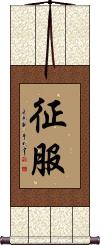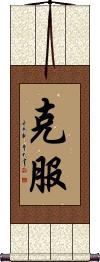Many custom options...
And formats...

Not what you want?
Try other similar-meaning words, fewer words, or just one word.
Feel free to email me with your request. If it's easy, I'll translate it for free and add it to this database of calligraphy for you.
Conquer Conquest in Chinese / Japanese...
Buy a Conquer Conquest calligraphy wall scroll here!
Personalize your custom “Conquer Conquest” project by clicking the button next to your favorite “Conquer Conquest” title below...
Conquer / Conquest
征服 means to conquer or conquest in Chinese, Japanese Kanji, and old Korean Hanja.
This can also be translated as vanquish, to subdue, subjugation, overcoming, or, to strike.
Note: This is kind of a violent term for a wall scroll but if you really want it, we’ll make it custom for you.
Overcome
Overcoming Hardships
In Chinese, Japanese Kanji, and old Korean Hanja, 克服 means “overcome” (as in overcoming hardships, etc.). It can also mean to conquer, to put up with, or to endure.
This can be a conquest over a problem, disease, handicap, poverty, or illness. Other definitions include overcoming, bringing under control, subjugation, or victory over something.
This can be used as an inspirational wall scroll to remind someone to try to overcome difficulties that may arise in life.
Not the results for conquer conquest that you were looking for?
Below are some entries from our dictionary that may match your conquer conquest search...
| Characters If shown, 2nd row is Simp. Chinese |
Pronunciation Romanization |
Simple Dictionary Definition |
克服 see styles |
kè fú ke4 fu2 k`o fu ko fu kokufuku こくふく |
More info & calligraphy: Overcome(noun, transitive verb) conquest (of a difficulty, illness, crisis, etc.); overcoming; surmounting; bringing under control |
征服 see styles |
zhēng fú zheng1 fu2 cheng fu seifuku / sefuku せいふく |
More info & calligraphy: Conquer / Conquest(noun, transitive verb) (1) conquest; subjugation; (noun, transitive verb) (2) overcoming (a difficulty); conquering (e.g. a mountain); mastery (of a skill) to strike |
The following table may be helpful for those studying Chinese or Japanese...
| Title | Characters | Romaji (Romanized Japanese) | Various forms of Romanized Chinese | |
| Conquer Conquest | 征服 | sei fuku / seifuku | zhēng fú / zheng1 fu2 / zheng fu / zhengfu | cheng fu / chengfu |
| Overcome | 克服 / 剋服 克服 | koku fuku / kokufuku | kè fú / ke4 fu2 / ke fu / kefu | k`o fu / kofu / ko fu |
| In some entries above you will see that characters have different versions above and below a line. In these cases, the characters above the line are Traditional Chinese, while the ones below are Simplified Chinese. | ||||
Successful Chinese Character and Japanese Kanji calligraphy searches within the last few hours...





